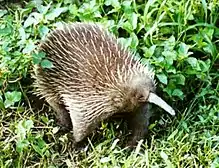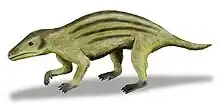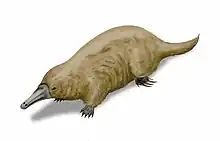Long-beaked echidna
The long-beaked echidnas (genus Zaglossus) make up one of the two extant genera of echidnas: there are three extant species, all living in New Guinea, and one extinct species which was present in Australia.[2] All echidnas are monotremes, and are medium-sized, solitary mammals covered with coarse hair and spines made of keratin. They have short, strong limbs with large claws, and are powerful diggers. They forage in leaf litter on the forest floor, eating earthworms and insects.
| Long-beaked echidnas[1] Temporal range: Miocene to present | |
|---|---|
 | |
| Western long-beaked echidna (Zaglossus bruijni) | |
| Scientific classification | |
| Domain: | Eukaryota |
| Kingdom: | Animalia |
| Phylum: | Chordata |
| Class: | Mammalia |
| Order: | Monotremata |
| Family: | Tachyglossidae |
| Genus: | Zaglossus Gill, 1877 |
| Type species | |
| Tachyglossus bruijni | |
| Species | |
| Synonyms | |
| |
The species are
- Western long-beaked echidna (Z. bruijni), of the highland forests;
- Sir David's long-beaked echidna (Z. attenboroughi), discovered by Western science in 1961 (described in 1998) and preferring a still higher habitat;
- Eastern long-beaked echidna (Z. bartoni), of which four distinct subspecies have been identified.
The one fossil species is:
The Eastern species is listed as vulnerable, while Sir David's and western long-beaked echidna species are listed as Critically Endangered by the IUCN.[3][4][5]
Species
Zaglossus attenboroughi
- Habitat: known only from the Cyclops Mountains of Papua, Indonesia, New Guinea
- Time: Holocene
- Critically endangered[3]
Zaglossus bartoni
- Habitat: on the central cordillera between the Paniai Lakes and the Nanneau Range, as well as the Huon Peninsula
- Time: Holocene
- Vulnerable[4]
Zaglossus bruijni
- Habitat: highland forests of West Papua and Papua provinces, Indonesia, New Guinea
- Time: Holocene
- Critically endangered[5]
†Zaglossus robustus
- Habitat: New South Wales
- Time: Miocene
- Fossil
- This species is known from a fossil skull about 65 cm long.
- It had many spikes along its back to protect it from its predators and used them as a weapon.
General information
The long-beaked echidna is larger than the short-beaked and has fewer, shorter spines scattered among its coarse hairs. The snout is two-thirds of the head length and curves slightly downward. There are five digits on both hind and forefeet, but on the former, only the three middle toes are equipped with claws. Males have a spur on each of the hind legs. This echidna is primarily a nocturnal animal that forages for its insect food on the forest floor. The animals are not usually found foraging in the daylight. The long-beaked echidna lives in dens and they are commonly found to be in burrows.[6] The breeding female has a temporary abdominal brood patch, in which her egg is incubated and in which the newborn young remains in safety, feeding and developing. Since they reproduce by laying eggs and are incubated outside of the mother’s body it is accompanied by the prototherian lactation process show that they are early mammals. The long-beaked echidna has a short weaning period. During this time milk is their only source of nutrition and protection for the hatchlings; they are altricial and immunologically naive.[7] Like the other species of echidna, long-beaked echidnas have vestigial spurs on their hind legs. These spurs are part of a repressed venom system. Male spurs are nonfunctional and females usually lose their spurs as they age.[8] Little is known about the life of this rarely seen animal, but it is believed to have habits similar to those of the short-beaked echidna; unlike them, however, the long-beaked echidnas feed primarily on earthworms rather than ants. The population of echidnas in New Guinea is declining because of forest clearing and overhunting, and the animal is much in need of protection.
In a study published in 2015 it has been shown that Zaglossus spp. in captivity exhibited "handedness" when performing certain behaviors related to foraging, locomotion, and male-female interactions. The results of this study suggest that handedness in mammals is a basal trait rather than one derived several times in extant mammals.[9]
Evolutionary history
The long-beaked echidna's posture is similar to a lizard with its limbs in a sprawling stance. Although the stances are similar, the way the limbs move are very different. The echidna has a 45 degree swing while a lizards is more horizontal. They also walk with two legs on one side of the body moving together.[10]
See also
References
- Groves, C.P. (2005). "Order Monotremata". In Wilson, D.E.; Reeder, D.M (eds.). Mammal Species of the World: A Taxonomic and Geographic Reference (3rd ed.). Johns Hopkins University Press. pp. 1–2. ISBN 978-0-8018-8221-0. OCLC 62265494.
- Werneburg, I.; Sánchez-Villagra, M. R. (January 2011). "The early development of the echidna, Tachyglossus aculeatus (Mammalia: Monotremata), and patterns of mammalian development". Acta Zoologica. 92: 75–88. doi:10.1111/j.1463-6395.2009.00447.x.
- Leary, T.; Seri, L.; Flannery, T.; Wright, D.; Hamilton, S.; Helgen, K.; Singadan, R.; Menzies, J.; Allison, A.; James, R.; Aplin, K.; Salas, L.; Dickman, C. (2016). "Zaglossus attenboroughi". IUCN Red List of Threatened Species. 2016: e.T136322A21964353. doi:10.2305/IUCN.UK.2016-2.RLTS.T136322A21964353.en. Retrieved 12 November 2021. Database entry includes justification for why this species is listed as critically endangered.
- Leary, T.; Seri, L.; Flannery, T.; Wright, D.; Hamilton, S.; Helgen, K.; Singadan, R.; Menzies, J.; Allison, A.; James, R.; Aplin, K.; Salas, L.; Dickman, C. (2016). "Zaglossus bartoni". IUCN Red List of Threatened Species. 2016: e.T136552A21964496. doi:10.2305/IUCN.UK.2016-2.RLTS.T136552A21964496.en. Retrieved 12 November 2021. Database entry includes justification for why this species is listed as critically endangered.
- Leary, T.; Seri, L.; Flannery, T.; Wright, D.; Hamilton, S.; Helgen, K.; Singadan, R.; Menzies, J.; Allison, A.; James, R.; Aplin, K.; Salas, L.; Dickman, C. (2016). "Zaglossus bruijnii". IUCN Red List of Threatened Species. 2016: e.T23179A21964204. doi:10.2305/IUCN.UK.2016-2.RLTS.T23179A21964204.en. Retrieved 12 November 2021. Database entry includes justification for why this species is listed as critically endangered
- Opiang, M. D. (April 2009). "Home ranges, movement, and den use in long-beaked echidnas, Zaglossus bartoni, from Papua New Guinea". Journal of Mammalogy. 90 (2): 340–346. doi:10.1644/08-MAMM-A-108.1.
- Bisana, S.; Kumar, S.; Rismiller, P.; Nicol, S. C.; Lefèvre, C.; Nicholas, K. R.; Sharp, J. A. (2013-01-09). "Identification and Functional Characterization of a Novel Monotreme- Specific Antibacterial Protein Expressed during Lactation". PLOS ONE. 8 (1): e53686. Bibcode:2013PLoSO...853686B. doi:10.1371/journal.pone.0053686. PMC 3541144. PMID 23326486.
- Whittington, Camilla; Belov, Katherine; Whittington, Camilla M.; Belov, Katherine (2014). "Tracing Monotreme Venom Evolution in the Genomics Era". Toxins. 6 (4): 1260–1273. doi:10.3390/toxins6041260. PMC 4014732. PMID 24699339.
- Giljov, Andrey (30 October 2015). "First record of limb preferences in monotremes (Zaglossus spp.)". Australian Journal of Zoology. 63 (5): 320–323. doi:10.1071/ZO15043. S2CID 85780231.
- Gambaryan, P. P.; Kuznetsov, A. N. (2013). "An evolutionary perspective on the walking gait of the long-beaked echidna". Journal of Zoology. 290 (1): 58–67. doi:10.1111/jzo.12014. ISSN 1469-7998.
- Flannery, T. F.; Groves, C. P. (January 1998). "A revision of the genus Zaglossus (Monotremata, Tachyglossidae), with description of new species and subspecies" (PDF). Mammalia. 62 (3): 367–396. doi:10.1515/mamm.1998.62.3.367. S2CID 84750399. Archived from the original (PDF) on 2006-08-25.
External links
- EDGE of Existence (Zaglossus spp.) – Saving the World's most Evolutionarily Distinct and Globally Endangered (EDGE) species
- ARKive – images and movies of the long-beaked echidna (Zaglossus spp.)
- A summary, including references, on animalinfo.org
- (Long Necked) Echidna find rewrites natural history books – 'Mount Anderson, West Kimberley'



